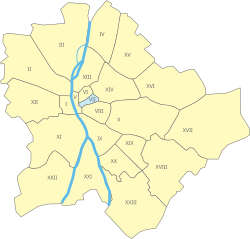Erzsébetváros
You can help expand this article with text translated from the corresponding article in Hungarian. (December 2009) Click [show] for important translation instructions.
|
Budapest - Erzsébetváros | |
|---|---|
District | |
   | |
 | |
| Country | Hungary |
| Region | Central Hungary |
| County | Budapest |
| Area | |
| • Total | 2.09 km2 (0.81 sq mi) |
| Population | |
| • Total | 62,034 |
| • Density | 29,681.3/km2 (76,874/sq mi) |
| Time zone | UTC+1 (CET) |
| • Summer (DST) | UTC+2 (CEST) |
Erzsébetváros (German: Elisabethstadt or Template:Lang-en) is the 7th district of Budapest, situated on the Pest side of the Danube. The inner half of the district was the historic Jewish quarter of Pest. The Dohány Street Synagogue, the largest functioning synagogue in Europe, is located in this district. Currently it is the most densely populated district of Budapest with 29,681.3 person per km2. In 1910 Erzsébetváros had 152,454 inhabitants. During the socialist era Erzsébetváros's population decreased rapidly, because young people and families moved to the newer "panelized" boom districts (Újpest, Újbuda, Óbuda, Kispest etc.). Gentrification and recovery started in the middle of the 2000s.
Name
Erzsébetváros was named after Queen Elisabeth, the popular wife of King Franz Joseph I on 17 January 1882.
Twin towns
Erzsébetváros is twinned with:
 Sveti Vlas, Bulgaria
Sveti Vlas, Bulgaria Požega, Croatia
Požega, Croatia Nevers, France
Nevers, France Stavroupoli, Thessaloniki, Greece
Stavroupoli, Thessaloniki, Greece Siedlce, Poland
Siedlce, Poland Stari Grad, Belgrade, Serbia
Stari Grad, Belgrade, Serbia Karlovac, Croatia
Karlovac, Croatia Safed, Israel
Safed, Israel
See also
Gallery
-
Madách square
-
Blaha Lujza square
-
the Synagogue
-
Square of Roses
External links
47°30′2″N 19°4′7.41″E / 47.50056°N 19.0687250°E






